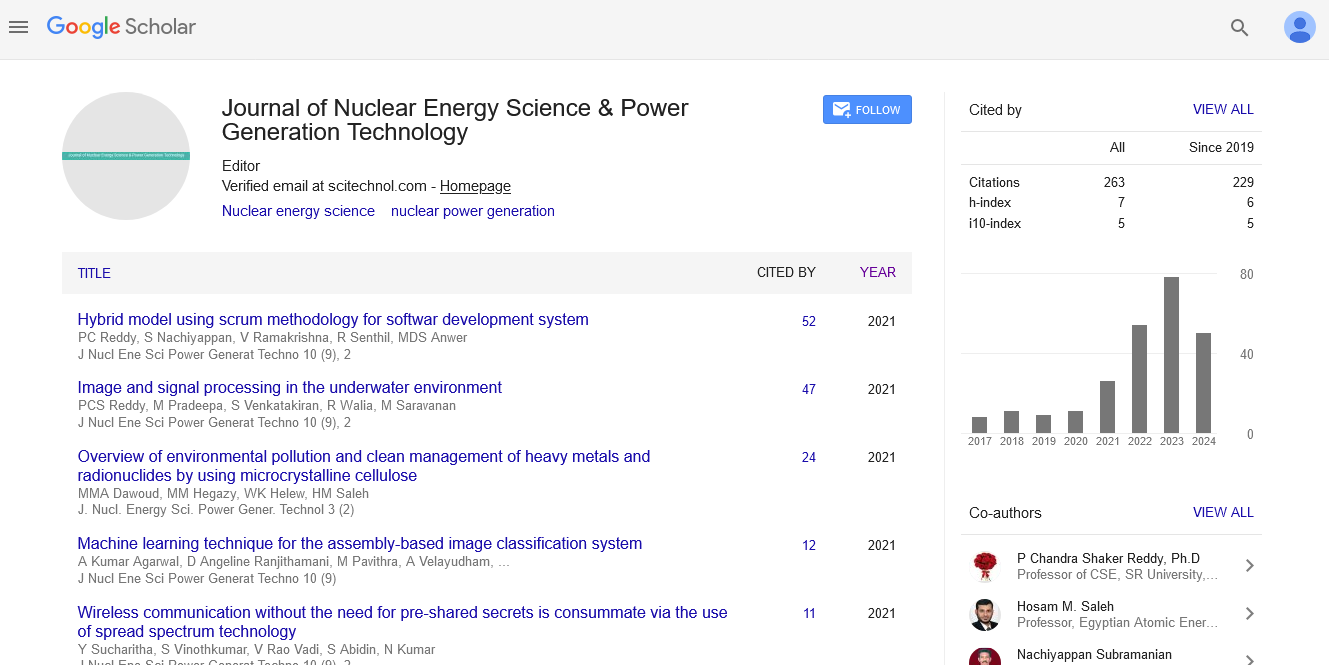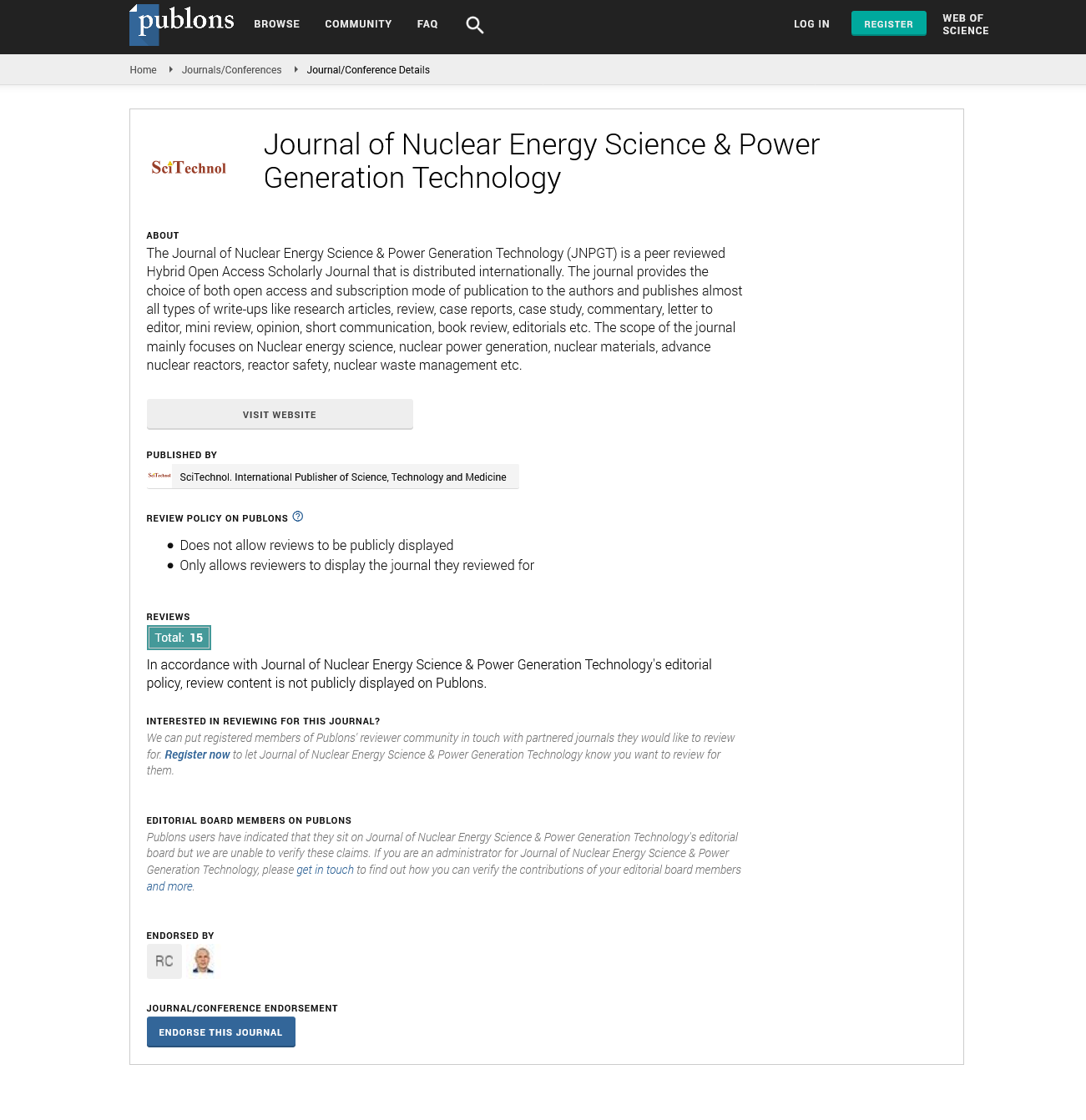Perspective, J Nucl Ene Sci Power Generat Technol Vol: 13 Issue: 6
Integrating Artificial Intelligence into Nuclear Power Plant Operations
Emi Thompson*
1Department of Nuclear Science and Technology, University of Tehran, Tehran, Iran
*Corresponding Author: Emi Thompson,
Department of Nuclear Science and
Technology, University of Tehran, Tehran, Iran
E-mail: emi_thompson49@gmail.com
Received date: 21 October, 2024, Manuscript No. JNPGT-24-154874;
Editor assigned date: 23 October, 2024, PreQC No. JNPGT-24-154874 (PQ);
Reviewed date: 06 November, 2024, QC No. JNPGT-24-154874;
Revised date: 13 November, 2024, Manuscript No. JNPGT-24-154874 (R);
Published date: 21 November, 2024, DOI: 10.4172/2325-9809.1000428.
Citation: Thompson E (2024) Integrating Artificial Intelligence into Nuclear Power Plant Operations. J Nucl Ene Sci Power Generat Technol 13:6.
Description
Nuclear Power Plants (NPPs) play a vital role in meeting global energy needs. However, ensuring their safe, reliable and efficient operation remains a significant challenge. Integrating Artificial Intelligence (AI) into nuclear power plant operations presents a transformative opportunity to enhance operational performance, safety and decision-making processes. AI refers to the simulation of human intelligence processes by machines, including learning, reasoning and self-correction. In the context of NPPs, AI technologies like Machine Learning (ML), neural networks and expert systems are being used to optimize operations, monitor systems and predict potential failures. AI algorithms can analyze sensor data in real-time to predict equipment failures before they occur. By identifying patterns and anomalies, these systems allow for timely maintenance, reducing unplanned outages and operational costs.
AI can optimize reactor core operations by adjusting parameters to maximize efficiency while adhering to safety regulations. Machine learning models analyze historical and real-time data to make recommendations, improving fuel utilization and reducing waste. AIpowered systems enhance safety by always monitoring important components and identifying potential risks. For instance, neural networks can simulate accident scenarios and suggest effective modification strategies, reducing the likelihood of catastrophic failures. Virtual reality (VR) and AI-based simulators provide immersive training environments for operators. Additionally, expert systems provide real-time guidance during complex situations, improving decision-making under pressure. AI controls big data analytics to derive actionable insights and identify trends. Digital twins are virtual replicas of physical systems. AI-powered digital twins allow operators to test scenarios and predict outcomes without disrupting real-world operations. NLP enables AI systems to interpret technical documentation and provide contextual recommendations, reducing the cognitive load on operators. AI systems streamline processes and optimize performance, leading to cost savings and better resource utilization. Continuous monitoring and predictive capabilities minimize the risk of accidents and improve response times in emergencies. By automating repetitive tasks and providing decision support, AI reduces the potential for human error, a major factor in nuclear incidents. AI systems must meet rigid regulatory requirements to ensure safety and reliability. AI depend on high-quality data for accurate predictions. Ensuring data integrity and protecting against cyber threats are important concerns. Integrating AI requires a cultural shift among plant operators and engineers. Training and awareness programs are essential to build trust in AI systems.
The implementation of AI technologies involves significant upfront investment in infrastructure, software and training. The integration of Artificial Intelligence (AI) into nuclear power plant operations signifies a transformative advancement in the energy sector. AI technologies have the potential to revolutionize how nuclear power is managed by enhancing operational efficiency, ensuring greater safety and supporting data-driven decision-making processes. These advancements could enable nuclear energy to reach its full potential as a basis of sustainable and reliable global energy systems, playing a vital role in growing energy demands while reducing carbon emissions. However, the journey toward fully AI-driven nuclear power plants is not without its challenges.
Conclusion
Important issues such as severe regulatory requirements, the need for high-quality, secure data and gaining the trust and acceptance of plant operators and stakeholders must be carefully navigated. Ensuring compliance with safety protocols while incorporating AI systems into traditionally manual processes requires a delicate balance of innovation and oversight. Despite these obstacles, the potential benefits of AI integration far outweigh the challenges. By developing continuous innovation and encouraging collaboration between industry leaders, regulatory bodies and AI specialists, the nuclear power sector can overcome these barriers. Investments in research and development, alongside education and training programs for operators, will be essential in realizing the seamless adoption of AI technologies.
 Spanish
Spanish  Chinese
Chinese  Russian
Russian  German
German  French
French  Japanese
Japanese  Portuguese
Portuguese  Hindi
Hindi 

